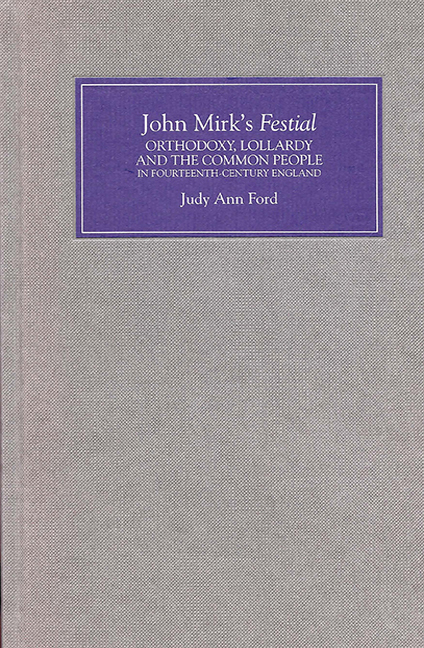Book contents
- Frontmatter
- Acknowledgements
- Contents
- Introduction: John Mirk's Festial and Fourteenth-Century England
- 1 Popular Culture and the Study of Late Medieval Piety
- 2 Clerical Power and Lay Agency
- 3 Secular Authority and Rebellion
- 4 Biblical Authority and Oral Tradition
- Conclusion: The Festial and Popular Piety in Late Medieval England
- Bibliography
- Index
Introduction: John Mirk's Festial and Fourteenth-Century England
Published online by Cambridge University Press: 11 May 2017
- Frontmatter
- Acknowledgements
- Contents
- Introduction: John Mirk's Festial and Fourteenth-Century England
- 1 Popular Culture and the Study of Late Medieval Piety
- 2 Clerical Power and Lay Agency
- 3 Secular Authority and Rebellion
- 4 Biblical Authority and Oral Tradition
- Conclusion: The Festial and Popular Piety in Late Medieval England
- Bibliography
- Index
Summary
For þus I rede of a woman þat had done an horrybull synne, and myght neuer, for schame, schryue hyr þerof. And oft, when ho come to schryf, scho was yn purpos forto haue ben schryuen; but euer þe fend put such a schame yn hur hert, þat scho had neuer grace to clanse hur þerofe. Then, on a nyght, as scho lay yn hur bed, and þoght moch on þat synne, Ihesu Crist come to hur and sayde: ‘My doghtyr, why wol þou not schew me þy hert, and schryue þe of þat synne þat þou lyse yn?’ ‘Lord,’ quod scho, ‘I may not, for schame.’ þen sayde Crist: ‘Schew me þy hond’; and toke hur hond, and put hit ynto hys syde, and sayde, and drogh hit all blody out. ‘Be þou no more aschamed to opyn þy hert to me, þen I am to opon my syde to þe.’
(For thus I read of a woman who had done a horrible sin, and might never, for shame, confess herself of it. And often, when she had come to confession, she intended to have been confessed; but every time the fiend put such a shame in her heart that she never had the grace to cleanse herself of it. Then, one night, as she lay in her bed and thought much on that sin, Jesus Christ came to her and said: ‘My daughter, why will you not show me your heart and confess yourself of that sin that you lie in?’ ‘Lord,’ said she, ‘I may not, for shame.’ Then said Christ: ‘Show me your hand’; and took her hand, and put it into his side, and sighed, and drew it all bloody out. ‘Be no more ashamed to open your heart to me then I am to open my side to you.’)
This short story of a women talking with Christ in the privacy of her bedroom resonates with the themes of much recent scholarship on lay piety in late-medieval England. The experience described is clearly mystical, yet it is expressed in the most tangible, physical language; it is Christocentric, affective, and focused on the blood of the Passion. In these ways the story powerfully echoes the experiences of such well-known fifteenth-century women mystics as Margery Kempe and Julian of Norwich.
- Type
- Chapter
- Information
- John Mirk's FestialOrthodoxy, Lollardy and the Common People in Fourteenth-Century England, pp. 1 - 15Publisher: Boydell & BrewerPrint publication year: 2006

